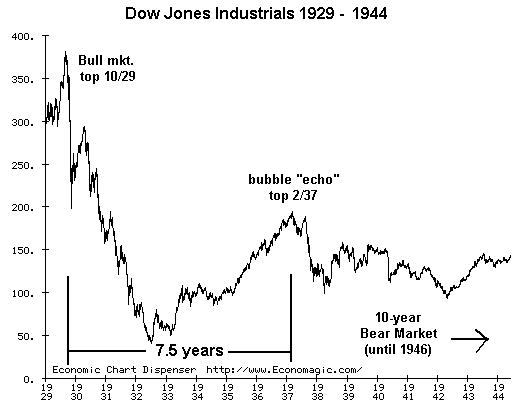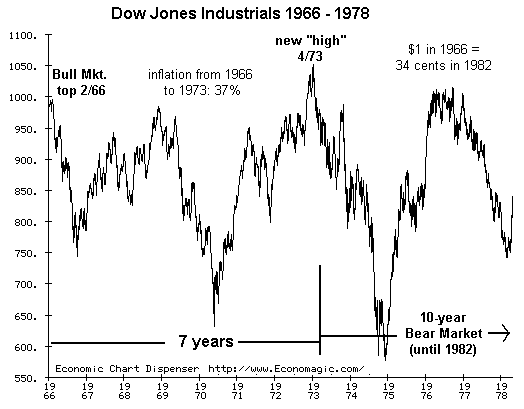

|
| weblog/wEssays archives | home | |
|
Crash or Malaise? (November 30, 2007) If we take as our starting point that global excesses are in the process of unwinding, then the Big Question is: will it come apart in a crash, or degrade in a decade of malaise? We have an example of each in the 20th century: the 1929 Crash and Great Depression (a deflationary collapse of a huge credit bubble) and the "stagflation" of the 70s (stagnation of wages, growth and profits in an inflationary spiral). Here are the charts of the stock market in those time frames: 
Here we see that once the "echo bubble" burst in 1937, the market--and the economy--noodled around in a downtrend until the U.S. mobilized for World War II. Some features of this era seem similar to our own: a wild expansion of credit and speculative fever, and the bursting of that excess in a long, painful deflationary decline in which goods and services cost less every year. The market climbed from 1932 to 1937 on the hope that "everything is back to normal." But of course it wasn't; the structural damage had yet to fully play out. As the line indicates, the echo-bubble crashed about 7.5 years after the market broke down. If we take the March 2000 market top as the analog, then we have to note that the October 2007 Dow Jones high is the analogous "echo-bubble top." Hmm. This deflation also bears similarities to Japan's "Lost Decade" (more like 17 years and running) after its stock and real estate bubbles burst in 1990. In a very real way, Japan has yet to extract itself from that deflationary spiral, even though it has borrowed and spent trillions in public "prime the pump" spending and kept government bond rates at the absurd level of .50% (one-half percent). 
This is a chart of alternating hope and despair. As structural problems sapped the economy and inflation gained, the market swung every few years from hope to despair, tracing volatile highs and lows of 40%. By the time the "decade of malaise" Bear market finally ended in 1982, $1 in 1966 had plummeted due to inflation to a mere 34 cents. Meaning that when the DJIA finally reached 1,000 again in 1982, those who had held onto their stocks during the Bear's 16 year reign (from 1966 to 1982) had lost 2/3 of their investment. (If the stocks paid a dividend, then the loss might have been cut to 50% - 60%.) So what will the next 10-16 years look like for us? 1937, 1977 or something completely different? As I described yesterday, the interconnectedness of the global economy has grown into a web of dependencies that far exceeds the oil exporter/consumer nexus established in the 1970s. International players who have never heard of the Trilateral Commission or The Plunge Protection Team are busy working their own Plunge Protection Teams--all of which depend on a healthy U.S. economy. Even our so-called "foes"--Venezuela, Iran and Russia--are all dependent on a robust global appetite for oil and natural gas. If the U.S. --fully 25% of the global GDP and consumer of 25% of the world's petroleum products--slides into a deep recession, then the dominoes of Asia and Europe topple, too, reducing global demand for oil and creating a glut of supply which will cut earnings of Iran, venezuela and Russia--perhaps severely. Recall the negative feedback loop of falling oil prices. As the price per barrel falls, governments which depend on oil revenues to placate their populations and fund their governments and militaries are in a terrible bind; they are spending every dime they get from oil, and can't afford to trim their budgets lest the citizenry and those feeding at the public trough become restive. So what do they do? Pump more oil to compensate for the lower price per barrel, which quickly exacerbates the oversupply, dropping the price ever lower. This feedback loop powered the 1997-98 drop in oil from above $30 to about $10--a catastrophic reduction in income for all oil-exporting nations. So what's different now? The world will try mightily to prop up an ailing U.S. economy. This argues not for a crash but for a 1970s-style decade of back-and-forth hope and gloom as the structural problems of the U.S. economy--unaffordable entitlements, widening deficits, crippled banking sector, debt-burdened consumers, sagging domestic profits, declining housing values, etc.--cause declines which are countered by "solutions" like lower interest rates, non-U.S. infusions of cash, etc. As Mish has so ably described, overburdened borrowers won't be able to borrow more, no matter how enticing the rates. And we are already seeing the non-U.S. infusions of capital coming--first with Citicorp, but why not Countrywide or a dozen other ailing lenders? Foreign investment in the U.S. is nothing new, of course. The U.K. remains one of the biggest owners of U.S. assets, and one of the astute Saudi princes bought 5% of Citicorp back in the 80s when it was trading for $5. He also bought a big chunk of Apple Computer when that firm's shares traded around $12/share in the mid-90s. The Japanese went on a real estate buying spree in the late 80s which drove up the price of real estate in Honolulu, Los Angeles and New York. Although foreign ownership sparks occasional handwringing and/or outrage, it has a long history. Yes, we can't allow strategic military assets Boeing or Lockheed or Intel to pass into foreign control, but Citicorp? Take the whole thing, please! If investors from Gulf oil exporting nations or China end up owning Citicorp, WAMU and Countrywide, what's the big deal? Maybe they'll demand some fiscal discipline and sound stewardship. So then the question becomes: can lower interest rates and foreign capital "fix" the structural problems rotting the core of the U.S. economy? Of course not. That's where the malaise comes in: structural deficits, global wage arbitration, a broken medical care system, a Medicare growing by 10% a year as the economy which supports it grows at 2%, a complete lack of forward-looking energy policy, a money-pit war without end, and so on. The crystal ball is cloudy, cloudy, I see only shapes, images, tendrils--but I do see one word that glows darkly through the mist: malaise. And if history is any guide, then the year 2016 looms as the earliest point when things could truly turn around. The cycles are long, and it is too far ahead to see with much precision, but we do know that, once enthroned, the Bear has reigned for 16-17 years. Thank you, Greg R., ($19.29), for your generous and numerically significant contribution to this humble site. I am greatly honored by your readership and support. All contributors are listed below in acknowledgement of my gratitude. For more on this subject and a wide array of other topics, please visit my weblog. copyright © 2007 Charles Hugh Smith. All rights reserved in all media. I would be honored if you linked this wEssay to your site, or printed a copy for your own use. |
||
| weblog/wEssays | home |